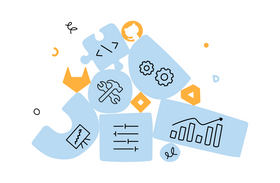Can Unstructured Data Be Stored in a Database?
Unstructured data does not conform to relational databases. Therefore, tools like NoSQL databases, data lakes, and data warehouses are needed to store it.
Published June 14, 2023.
Our world today is driven by data. But between structured data, which can be easily stored in a relational database, and unstructured data, which doesn't conform to a predetermined format, organizing can be tricky. Especially since IDC notes that 80-90% of data is unstructured.
But is there a way to store unstructured data, even though it's notoriously difficult to organize and search? A NoSQL database—a non-tabular database—is the top way to store unstructured data.
Here's all you need to know about storing unstructured data.
How to Store Unstructured Data
Unstructured data comes in numerous forms, like photos, videos, emails, and other media. And data analysts and engineers use the following methods to store this data:
NoSQL Databases
These databases are flexible and scalable. Unlike relational databases, NoSQL databases use different data models, like graph-based structures or document-orientated ones to store data that's easy to search through.
However, a NoSQL database requires more server space due to its qualitative method of storing and organizing data.
Data Lakes
Imagine various streams of structured and unstructured data flowing into a single reservoir. That’s what a data lake is. They are convenient and flexible storage solutions for large and ever-growing bodies of raw data.
However, the raw data requires consistent organization to be usable.
Data Warehouses
Unlike the raw data in a data lake, a data warehouse stores processed data. This data is structured and ready to be examined or analyzed. It provides a ready resource for those looking to glean insights from existing databases.
✶ Learn more about data silos and data lakes
Manage Unstructured Data Without Hassle
To help companies deal with large amounts of unstructured data, Unleash offers a powerful enterprise search tool that delivers results from across data sources. This tool is easy to use and integrates with your company portal, third-party apps, and browsers. This way, you can streamline data search queries to boost your organization’s productivity.
Related Articles

Slack Search Sucks: Here’s Why (And 5 Tips to Help You Find What You Need)
Noam Limor
May 17, 2023

Forget Organizing Files: Leverage Advanced Search Tools Instead
Roy Shaked
March 30, 2022

How to Preserve Institutional Memory During the Great Resignation
Noam Limor
May 5, 2022

Using Notion for Project Management: Pros, Cons, & More
Marcel Deer
September 12, 2023

Building an Internal Communications Strategy: A Step-By-Step Guide
Marcel Deer
February 24, 2023
Related Posts
Ashley Stander
What Causes Data Integrity Issues?
Ashley Stander
What Is Data Integrity in a Database?
Brody Hall
What Is Data Federation?
Marcel Deer
